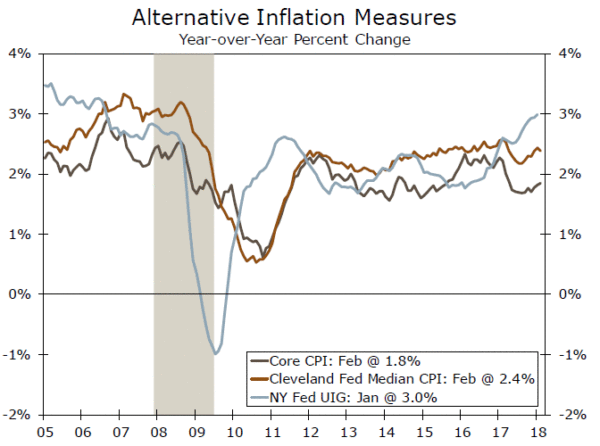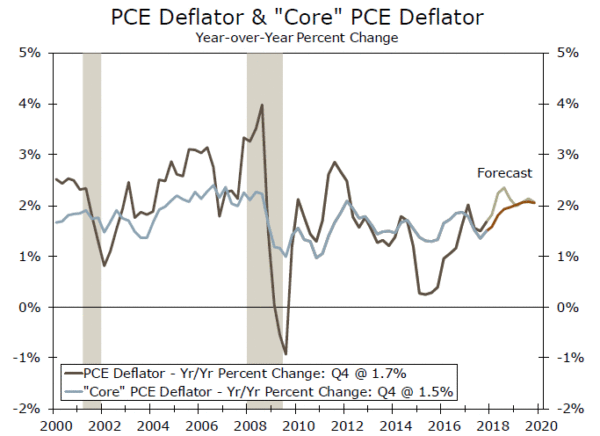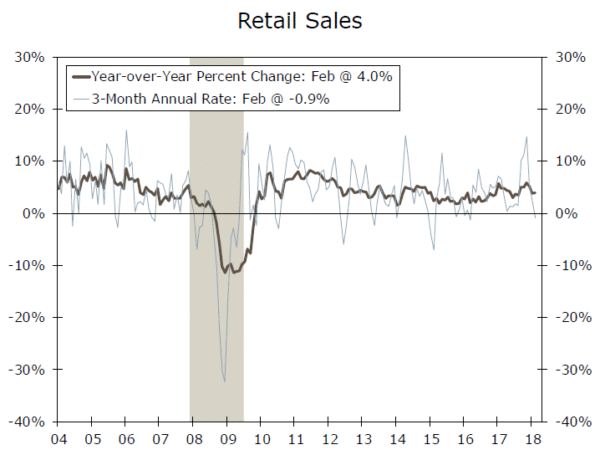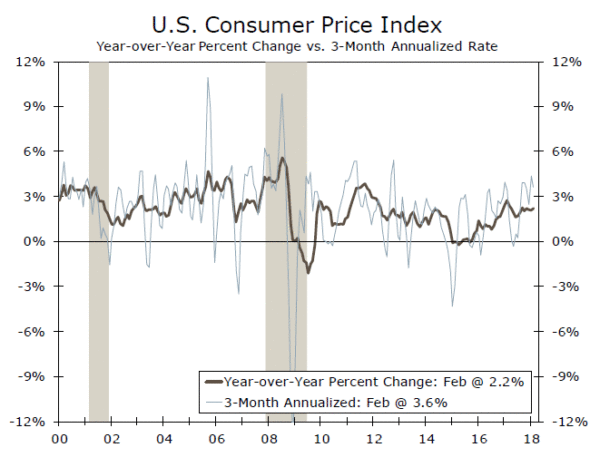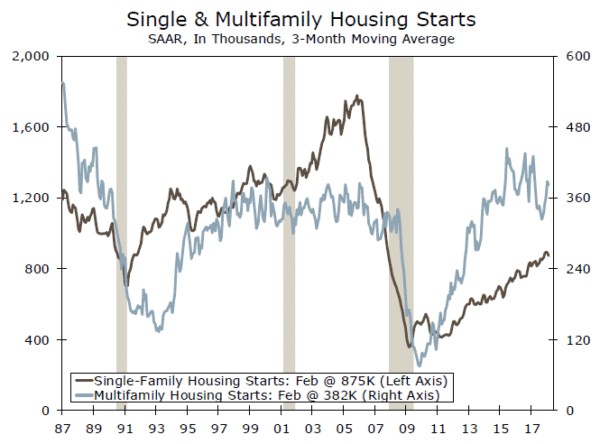U.S. Review
Inflation Showing Signs of Taking a Bite Out of Growth
- Consumer prices rose 0.2 percent in February, taking the yearover- year rate of inflation up to 2.2 percent. Other measures of inflation for the month also showed price pressures building.
- Retail sales fell for the third straight month in February, reinforcing our view that consumer spending has downshifted to start the year.
- Industrial production bounced back in February after declining 0.3 percent in January. Manufacturing output rose 1.2 percent for the month. Housing starts declined in February after a 10.1 percent surge to start the year.
Inflation Showing Signs of Taking A Bite Out of Growth
Economic data this week signaled that inflation has begun to rise and may be adversely affecting consumer spending. Consumer Price Index (CPI) data showed an increase in the headline inflation rate, a trend that was reinforced by the Producer Price Index and import price data. Retail sales data posted their third month in a row of sales declines, raising questions about the strength of the consumer sector in the first quarter. Housing starts slowed in February following a strong reading in January. Industrial production picked up for the month, reflecting improving fundamentals in the sector.
Retail sales edged down 0.1 percent in February, with broad-based declines in a number of categories. Excluding auto sales, total sales rose 0.2 percent. The closely-watched control group, which feeds into the calculation for GDP, rose a modest 0.1 percent for the month following a flat reading in January. Much like the business investment sector, a stark divergence has emerged between the “soft” consumer confidence data and the “hard” consumer spending data. We maintain the view that first quarter consumer spending is likely to come in softer than expected, held back in part by firmer inflation readings. That said, we do not see evidence of an erosion in consumer fundamentals and expect consumer spending to pick up throughout the rest of this year.
Inflation readings in February continued to support our forecast for a faster pace of price increases this year. Both the headline and core CPI index rose 0.2 percent for the month, taking the headline reading to 2.2 percent on a year-over-year basis. Producer prices rose 0.2 percent, or 2.8 percent on a year-over-year basis. Import prices surprised to the upside, posting a 0.4 percent increase for the month. Nonfuel import prices rose at an impressive 0.5 percent rate, marking the largest monthly gain since 2011. Leading up to the March announcement of steel and aluminum tariffs, import prices for both metals were already up by double digits this past year. We will continue to monitor the data for any further effects from the tariffs on import prices.
Housing starts fell 7.0 percent in February to a 1.24 million-unit pace. Single family starts rose 2.9 percent to a 902,000-unit pace, while the more volatile multi-family starts declined 26.1 percent to a 334,000-unit pace. Housing starts are typically quite volatile in the first quarter, so we are not reading too much into the February decline. We are forecasting total housing starts of 1.31 million this year compared to 1.20 million units last year.
Industrial production bounced back in February, rising 1.1 percent in the wake of January’s 0.3 percent decline. Utilities output declined 4.7 percent after rising 1.3 percent in January. Manufacturing output rose 1.2 percent on the month after a downwardly-revised 0.2 percent decline in January. Capacity utilization rose for the month but remains below its historical average, implying that more capacity can be brought online, reducing the need for further business fixed investment. As global and domestic demand builds this year we expect industrial production to expand 3.3 percent in 2018 relative to last year.
U.S. Outlook
Current Account • Wednesday
The current account deficit narrowed to a three-year low of $100.6 billion in Q3 from $124.4 billion in Q2, largely due to higher income payments on foreign assets and a narrower trade deficit in goods and services. The Q3 financial account, the counterpart to the current account in the balance of payments, also showed solid foreign direct investment of more than $95 billion for the quarter. Foreign demand for Treasuries remained strong in Q3, although it has since slowed, and foreigners became net sellers of Treasuries to end 2017. We look for the current account deficit to widen to $129.0 billion in Q4, mainly due to a larger trade deficit, as trade in goods and services makes up most of the current account. The trade deficit rose to $652.2 billion in Q4, and we look for it to widen further this year. Our currency strategy team forecasts that the dollar will depreciate against most major currencies over the coming year, with some of this weakness coming from a wider current account deficit.
Previous: -$100.6B Wells Fargo: -$129.0B Consensus: -$125.0B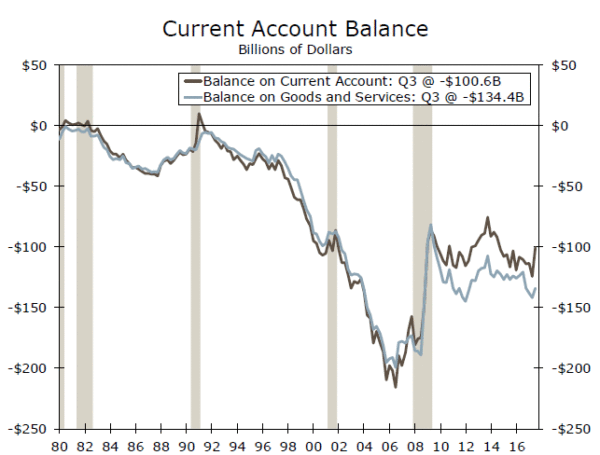
FOMC Meeting • Wednesday
While the Federal Open Market Committee (FOMC) left rates unchanged at its January meeting, we look for it to raise the fed funds rate 25 bps at next week’s meeting. Inflation has gathered momentum in recent months, with core inflation now running at a 3.1 percent three-month annualized rate in February. Average hourly earnings growth also remained solid in February after a strong 2.8 percent year-over-year gain in January, and the labor market continues to tighten. In light of higher inflation, rising inflation expectations and a solid employment outlook, we now forecast four rate hikes in 2018. Market expectations of a rate hike next week are also largely penciled in, especially after new Fed Chair Jerome Powell indicated a slightly more hawkish outlook during his first congressional testimony a few weeks ago. The FOMC will also update its economic projections and its closely-watched “dot plot” at next week’s meeting.
Previous: 1.50% Wells Fargo: 1.75% Consensus: 1.75%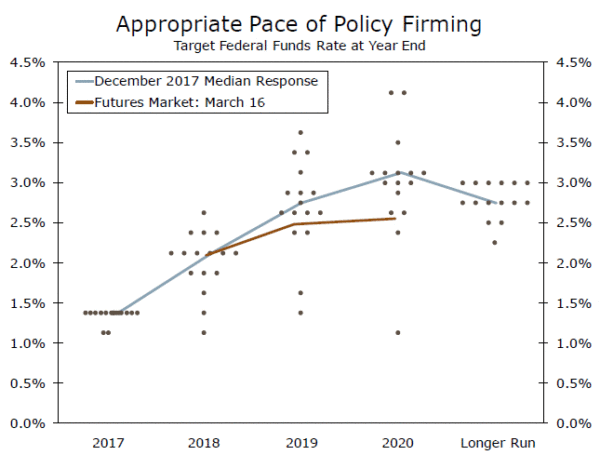
Durable Goods • Friday
January’s durable goods report added another mark to recently underwhelming production data, with durable goods orders down 3.6 percent month over month. Looking beyond the weakness in the volatile transportation sector, the data showed a more pronounced slowdown. Core capital goods orders fell 0.1 percent over the month on the heels of a 0.6 percent drop in December.
January’s weak durable goods report combined with similar declines in industrial production and factory orders is increasingly becoming at odds with the still-strong survey data reflected in the ISM indices. The ISM manufacturing index hit a 13-year high of 60.8 in February, continuing its recent upward trend. However, the survey data should likely converge with the hard data in the coming months. We look for durable goods orders to rise 1.5 percent in February, but weakness in the core capital goods orders component is likely telling of the slower pace of equipment spending we forecast for Q1.
Previous: -3.6% Wells Fargo: 1.5% Consensus: 1.6% (Month-over-Month)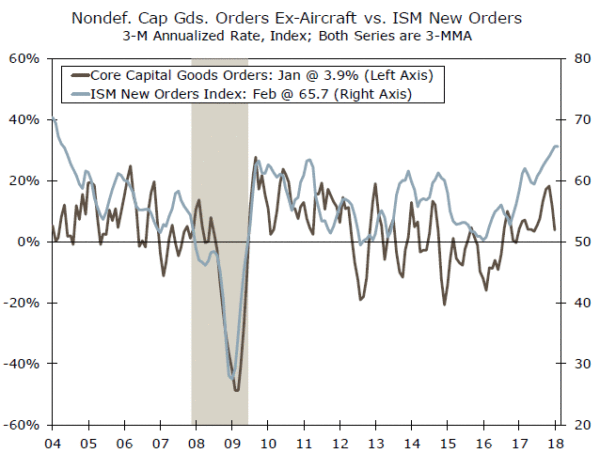
Global Review
More Signs of Firming in Indian Economy
- Economic news out of India this week was broadly better than expected. That reinforced our view that with some of the structural reforms already implemented, India’s economy should be a top performer over the next few years.
- Elsewhere in the global economy, we also learned this week that Chinese retail sales in February were slightly softer than expected, growing at just 9.7 percent year over year, a slowdown from 10.2 percent the month prior.
- In the Eurozone, industrial production fell 1.0 percent in January, which brought down the year-over-year rate to 2.7 percent.
Indian Economy Gaining Momentum
After implementing some measures that slowed the pace of GDP growth in recent years, India’s economy remains on track as one of the fastest-growing economies in the world. Economic indicators out of India have generally been better than expected in recent weeks and months, and that theme remained more or less intact this week as well.
The second half of 2017 was marked by a rising rate of inflation in India, which stoked concerns that the Reserve Bank of India might eventually need to raise its repo rate. Since the start of the current year, some of that pressure has eased as inflation has come off the boil. In January, the year-over-year rate of CPI inflation slowed for the first time in six months coming in at just over 5 percent, and we learned this week that in February it slowed further to just 4.4 percent. That was even more of a slowing than the 4.7 percent rate that had been expected and it takes some pressure off the RBI to raise rates at the upcoming April meeting.
We also learned this week that year-over-year growth rate of industrial production in India quickened to 7.5 percent in January, which was more than the 6.4 percent that had been expected. All major categories were positive when compared to where they were a year ago.
The improvement in industrial production is consistent with our real GDP forecast for the Indian economy of 6.7 percent in 2018 before picking up to 7.4 percent in 2019. In each of the next two years, the numbers we have for India’s economy are the fastest of any of the economies we cover, but it is not without its challenges.
To be sure, there are some pretty substantial hurdles that have already been cleared. The “demonetization” or removal of larger denomination currencies late in 2016 led to some retrenchment in consumer spending that weighed down growth in the first half of 2017.
The comprehensive rollout of a five-tiered goods and services tax (GST) was introduced in July 2017 to replace the pre-existing and somewhat confusing system which overlapped multiple different taxes at different levels of the government. Both the demonetization and GST were seen as necessary reforms, which weigh on growth in the short-run but help longer term.
The Indian economy grew faster than expected in Q4, lifting the year-over-year growth rate to 7.2 percent. Not all the news at the time was good, however. We observed in a report earlier this month that after the GDP report printed, export growth slowed sharply and consumer spending slowed in the quarter as well. Exports grew 9.1 percent year over year through January, and we learned this week that the figure for February was 4.5 percent. That, combined with a modest narrowing in the trade deficit, suggest some improvement in trade dynamics for the first quarter of 2018.
India has gotten through some growing pains and has more structural reform to do, but data this week show the economy remains on the right track and is gaining momentum.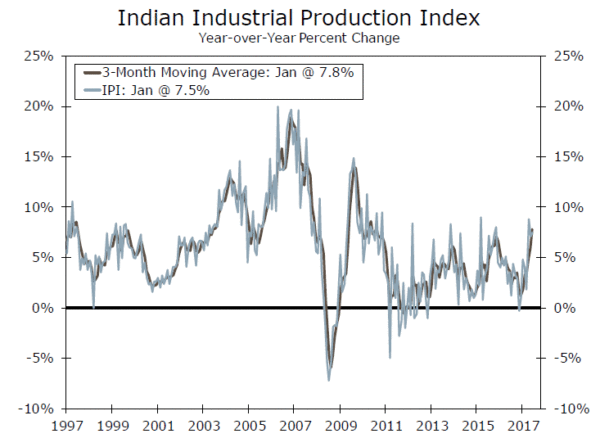
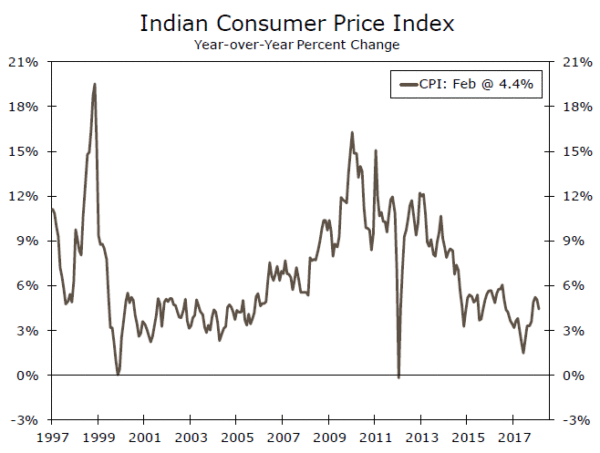
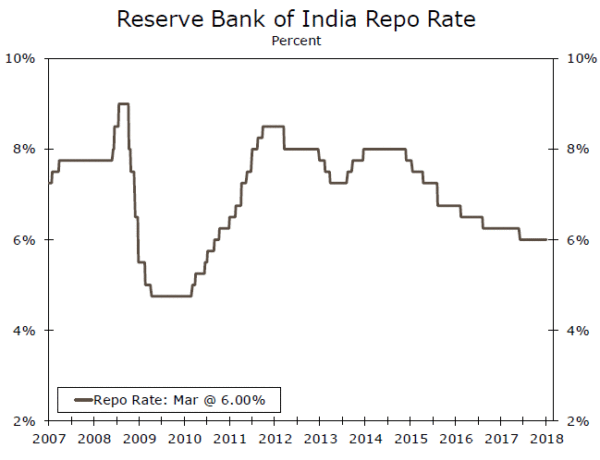
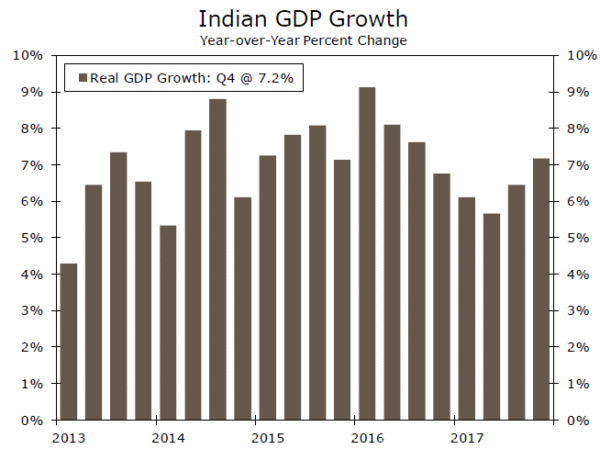
Global Outlook
Brazilian Economic Activity Index • Monday
The Brazilian economy has continued to recover from a deep recession that occurred over the 2015-2016 period. Real GDP was up 2.1 percent on a year-ago basis in Q4, the fastest pace of growth since Q1-2014. The external sector helped boost economic growth, as real exports climbed 9.1 percent year over year in the fourth quarter. Private consumption and gross fixed capital formation also continued to accelerate in the quarter, signaling a broad-based recovery.
The Brazilian Economic Activity Index, published on a monthly basis by the central bank, will offer the first look at whether the momentum at the end of 2017 was carried into the new year. We remain positive on the direction of the Brazilian economy, though political turmoil remains a key risk to the outlook. Our current forecast for Brazilian economic growth is 2.8 percent in 2018 and 3.3 percent in 2019
Previous: 1.4% Consensus: -0.40% (Month-over-Month)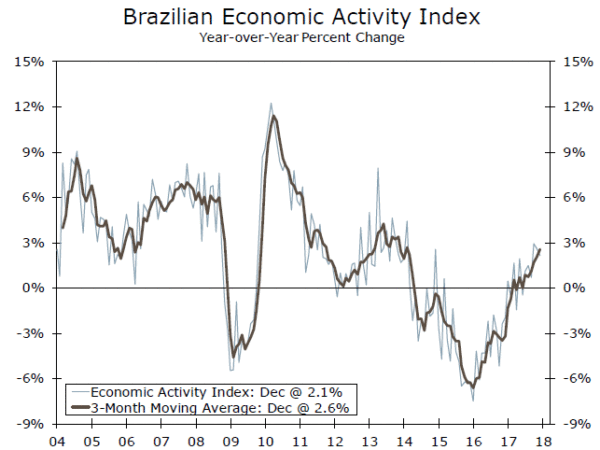
Bank of England Meeting • Thursday
A slew of economic data is to be reported next week in the United Kingdom, culminating in a meeting of the Monetary Policy Committee (MPC) of the Bank of England (BoE). The February consumer price index will be reported on Tuesday, and policymakers will be keeping a close eye on the currently above-target inflation numbers. Data on weekly earnings and unemployment will print on Wednesday, and Thursday will see retail sales data and a decision by the MPC on monetary policy.
BoE policymakers face a different set of challenges relative to most of their developed-economy counterparts. Inflation in the U.K. is above- rather than below-target, while economic growth has not noticeably strengthened as it has in the United States and the Eurozone. Stubbornly high inflation and/or faster wage growth would help reassure policymakers that additional rate hikes are warranted in the coming months.
Previous: 0.50% Wells Fargo: 0.50% Consensus: 0.50% (Bank Rate)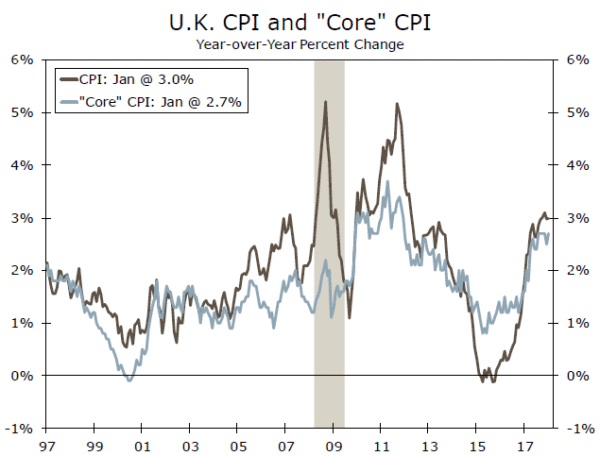
Canadian CPI • Friday
Despite a strong economic performance in 2017, inflation remained contained in Canada last year, with core price growth remaining comfortably within the Bank of Canada’s (BoC) target band. In its policy statement released last week, the BoC noted that “inflation is fluctuating because of temporary factors related to gasoline, electricity, and minimum wages.”
The BoC has been quick to respond to favorable economic data with tighter monetary policy. Economic growth slowed in H2-2017 after a breakneck pace in H1, and employment has outright declined through the first two months of 2018 after robust growth in Q4-2017. High household debt levels remain an ongoing concern for both us and policymakers at the BoC. With economic growth coming back down to earth and inflation in check, the BoC can afford to remain on hold for the time being as it continues to evaluate the incoming data.
Previous: 1.7% Wells Fargo: 1.8% Consensus: 2.0% (Year-over-Year)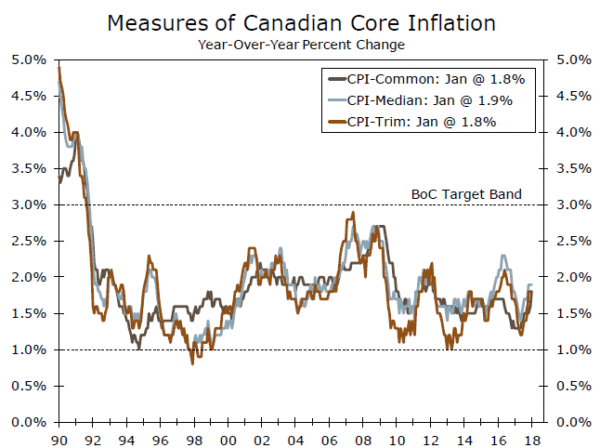
Point of View
Interest Rate Watch
Unease of Policy Resolution
Economic policy experiments offer the promise of benefits (greater growth) but also bring the possibility of greater risks (volatile prices for credit, currencies and goods). Currently, U.S. economic policy is carrying on two experiments at once: fiscal stimulus as the economy operates with a minimal output gap and monetary policy that both raises the price of credit (rate hikes) and reduces the supply of credit (balance sheet reductions). We remain concerned about the results.
Two Untried Experiments at Once
As illustrated in the top graph, higher fiscal deficits for the next two years will bring more Treasury issuance to market at a time when the Federal Reserve has stated its intentions to reduce its balance sheet and thereby reduce its demand for Treasuries.
Moreover, increased Treasury issuance is now being carried out in an economic environment of rising inflation and a weaker dollar (middle graph). Our concern here is that tariff talk will tend to bias inflation upward and lower the dollar’s value relative to the current outlook.
Higher Short-Term Rates Ahead
The Fed will be tested on its commitment to 2 percent inflation and a reduction in the balance sheet in the face of widening fiscal deficits. In our Monthly Economic Outlook released this week, we revised our fed funds forecast to four rate hikes in 2018, up from our previous forecast of three. Fiscal stimulus is helping to drive economic growth above potential growth late in the economic cycle, and we expect the Fed to respond accordingly. Widening deficits and balance sheet reductions will occur in the face of a continued path higher for the fed funds rate in 2018 and 2019 (bottom chart).
Economic Mythbusters
From our view, there are too many moving parts in this experiment. Expansionary fiscal policy in the face of tighter monetary policy sets up numerous tensions in interest rates, the dollar and growth. We are cautious on the view that policymakers will be able to coordinate both fiscal and monetary policy to a soft landing, given the cross winds of inflation and the downdraft of the dollar.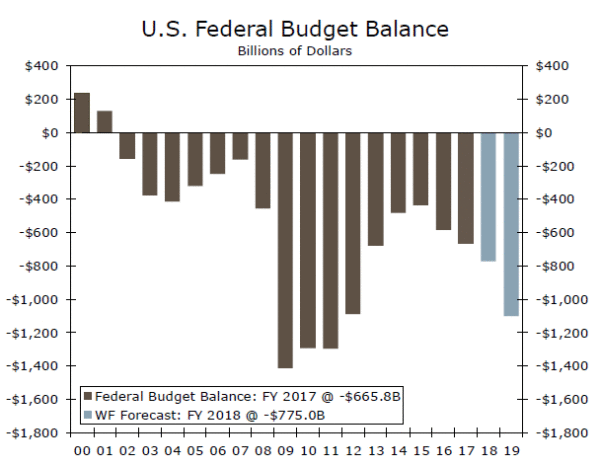
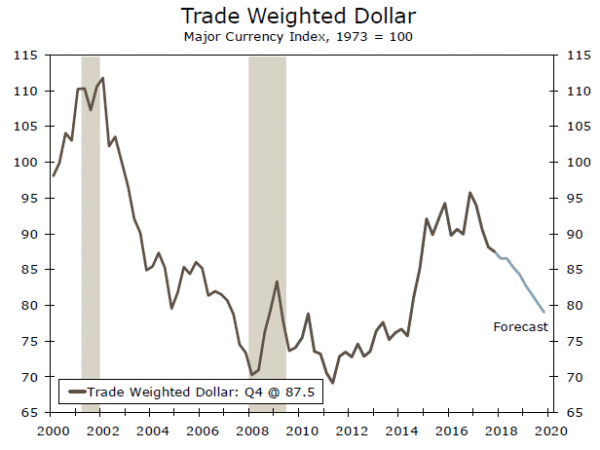
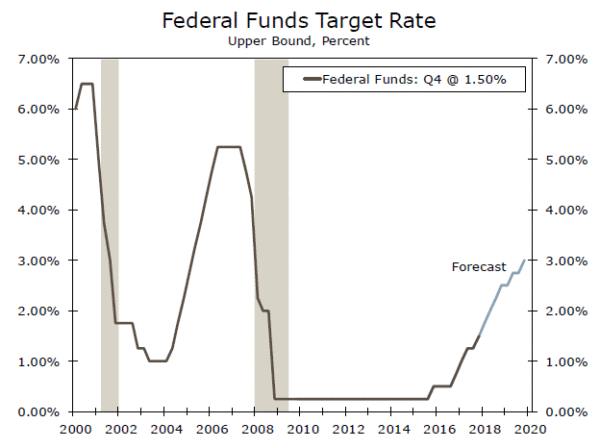
Credit Market Insights
Is Household Debt a Growing Worry?
Last week, the Federal Reserve released the Financial Accounts of the United States for Q4-2017. The release points to stable economic conditions among households. The data revealed that household net worth increased for the ninth consecutive quarter. Each quarter has continuously surpassed the all-time high level of household net worth, which currently stands at $98.7 trillion. Rising $2.1 trillion (NSA) in Q4, much of the gain was due to increased financial assets, a likely effect of the continuation in the bull market over the period.
Total household borrowing, however, increased $789.5 billion, at a seasonally adjusted annual rate (SAAR), over Q4. This was the largest quarterly increase since Q4-2007. A large contributor to this rise was the notable increase of $292.1 billion (SAAR) in consumer credit, which is a historic high quarterly increase for the series. Although we acknowledge consumer deleveraging may have neared an end in this cycle, monthly debt and other obligation payments remain near historic lows. Furthermore, liabilities as a percent of assets stand at their lowest level not only in this expansion, but since Q1-2000.
At present, household debt dynamics do not impart worry to our outlook, as the fourth quarter data show stable conditions. Although consumer spending started the year weakly, we expect stable credit conditions this year to foster steady levels of consumer spending.
Topic of the Week
Rising Inflation, Rising Fed Funds Path
Low inflation has kept the Fed on a restrained path of tightening so far in this cycle. Recent inflation data, however, have reinforced our view that price pressures are picking up. Core readings of both the Consumer Price Index (CPI) and PCE deflator posted solid gains to start the year. This week’s core CPI print backed up an impressive gain in January and has left core CPI over the past three months rising at the fastest clip in 10 years.
Alternative measures of core inflation have also perked up, while input costs—including labor—are rising. Notably, markets have started to come around to the prospects for higher inflation, fueled by bets that fiscal stimulus at this late stage of the economic cycle will finally lead to a breakout in inflation. The weakening trend in the dollar and recent steel and aluminum tariffs also stand to lift inflation, albeit only modestly.
We still expect the pickup in inflation to remain orderly. Core inflation tends to adjust slowly around its longerterm trend, while structural headwinds that have weighed on inflation are not suddenly disappearing. Profit margins also look historically high economy-wide, suggesting at least some scope for businesses to absorb higher input costs, although this need not be the case if productivity improves. While the recently-passed tax plan will support household spending, inflation will likely be contained by stronger capital spending boosting productivity and lower tax rates helping firms absorb rising labor costs. The potential for trade restrictions to escalate, however, represents a meaningful upside risk to inflation.
We look for the PCE deflator to reach 2 percent as soon as next quarter, with core PCE inflation rising to 2.0 percent by Q4. The forward momentum and higher inflation expectations has led us to raise our forecast for the fed funds rate this year. We now expect the Fed to raise rates four times this year, rather than the three hikes estimated in the Fed’s December projections.